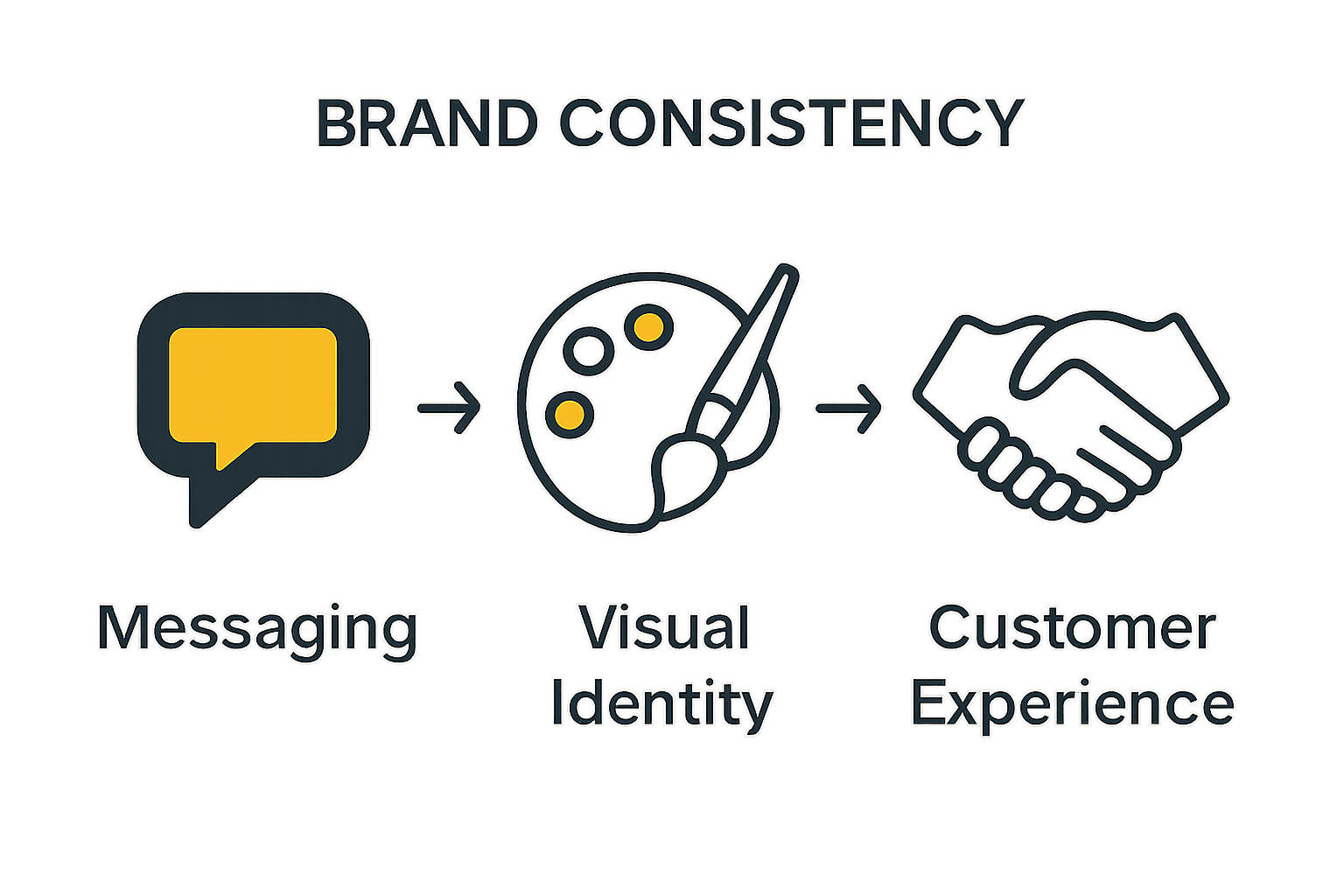Branding Strategies: Building Impactful Small Businesses

Learn what consistency in branding means, why it matters, key elements, common pitfalls, and strategies for sustained brand trust in this comprehensive guide.

Did you know that brands with consistent messaging can increase their revenue by up to 23 percent? Consistency in branding goes far beyond using the same logo or colors. It shapes how people recognize, trust, and remember who you are at every touchpoint. Understanding the true impact of brand consistency helps you build lasting connections with your audience while making your business stand out among countless competitors.
Branding consistency is more than just using the same logo everywhere. It’s about creating a unified brand personality that speaks authentically across every single customer touchpoint. Think of your brand like a person with a distinctive personality - one who sounds and looks the same whether they’re at a professional conference or grabbing coffee with friends.
At its core, brand consistency involves maintaining uniformity in several critical areas:
Research highlights that consistent branding isn’t just aesthetically pleasing - it’s a powerful trust-building mechanism. According to academic research, brands that present a cohesive set of human qualities through their content can significantly enhance customer retention and credibility. When your audience encounters a consistent experience, they develop a sense of reliability and familiarity with your brand.
Think of brand consistency like constructing a memorable character in a story. Every interaction should feel like it’s coming from the same persona, creating a narrative that your audience can connect with emotionally and intellectually. It transforms your brand from a faceless business into a relatable, trustworthy entity that customers want to engage with repeatedly.

Building a consistent brand is like assembling a complex puzzle where every piece must align perfectly. Brand Principles form the foundational cornerstone, encompassing your mission statement, core values, and the fundamental beliefs that drive your business forward. These principles act as the north star guiding all your brand communication and strategic decisions.
The key components shaping brand consistency can be broken down into three critical areas:
Here’s a summary of the core elements that shape brand consistency:
| Element | Purpose | Examples |
|---|---|---|
| Brand Messaging | Communicate values & mission | Mission statement Email content Taglines |
| Brand Visual Elements | Create a unified visual identity | Logo Color palette Typography |
| Customer Experience | Ensure consistent interactions | Website UX Support responses Social media |

Research indicates that successful brands meticulously craft each of these elements to create a holistic, unified brand experience. Visual consistency isn’t just about using the same colors or logo - it’s about creating a recognizable visual language that instantly communicates your brand’s personality. Similarly, your messaging should maintain a consistent tone and voice whether you’re publishing a social media post, writing a website page, or sending a customer email.
Think of your brand as a living, breathing entity with its own unique personality. Just like a person develops a consistent way of speaking, dressing, and interacting with the world, your brand must develop its own distinctive and reliable character. When every interaction feels authentic and aligned, you create a powerful emotional connection that transforms casual customers into loyal brand advocates.
Brand consistency isn’t just a marketing buzzword - it’s a strategic powerhouse that drives tangible business growth. Business Recognition happens when customers can instantly identify your brand across multiple platforms, creating a sense of familiarity that transforms casual interactions into lasting relationships.
The impact of consistent branding is profound and measurable:
Research demonstrates that brands maintaining consistent visual and messaging elements experience significant advantages. Companies with uniform branding across all touchpoints are more likely to see increased customer engagement and perceived professionalism. When your color palette, typography, tone of voice, and messaging remain consistent, you’re essentially creating a visual and emotional shorthand that customers can quickly recognize and connect with.
Think of brand consistency like building a reputation. Just as a person develops a trustworthy character through consistent behavior, your business builds its brand identity through predictable, reliable communication. Every touchpoint - from your website to social media, email communications to customer service interactions - becomes an opportunity to reinforce your brand’s unique personality and values. The result? A powerful, memorable brand that stands out in a crowded marketplace and turns casual observers into committed advocates.
Brand consistency isn’t about perfection - it’s about intentional, strategic alignment. Inconsistent Branding can unravel your carefully crafted image faster than you might imagine, creating confusion and eroding customer trust in ways that are difficult to repair.
Here are the most critical mistakes entrepreneurs and businesses make:
Research highlights that organizations without a unified approach to brand representation risk significant credibility loss. A comprehensive style guide isn’t just a document - it’s your brand’s DNA blueprint. This guide should meticulously outline everything from color palette and typography to communication tone and visual asset usage. Without such a reference, your team members become like actors without a script, each interpreting the brand differently.
Think of your brand like an orchestra. Each instrument (or team member) must play from the same musical score to create harmony. When someone goes off-key, the entire performance suffers. By establishing clear guidelines, providing consistent training, and creating easy-to-access brand resources, you transform potential chaos into a symphony of coordinated brand expression. The goal isn’t rigid conformity, but a flexible framework that allows creativity while maintaining your core brand identity.
Creating a sustainable brand consistency system isn’t a one-time project - it’s an ongoing strategic commitment. Brand Infrastructure requires careful planning, robust documentation, and continuous refinement to ensure your brand remains cohesive and compelling across every single interaction.
The foundational elements of a sustainable brand consistency system include:
Research emphasizes that successful brand consistency isn’t just about creating guidelines, but about embedding those principles into your organization’s DNA. Your style guide should be a living document that evolves with your business, providing crystal-clear instructions on visual representation, tone of voice, messaging frameworks, and acceptable variations. Think of it as your brand’s operating manual - detailed enough to provide structure, but flexible enough to allow creative interpretation.
Important implementation strategies include cross-team training, creating easily accessible brand resource libraries, and developing feedback mechanisms that allow continuous improvement. Your goal is to transform brand consistency from a theoretical concept into a practical, actionable system that every team member understands and can execute effortlessly. When done right, your brand becomes more than a set of visual guidelines - it becomes a shared language that connects your entire organization and resonates powerfully with your audience.
Struggling to keep your brand message and visuals aligned across every customer touchpoint? This guide on consistency in branding points out the crucial steps to create a unified, trustworthy brand personality that your audience recognizes and trusts. If your brand feels fractured or your messaging wavers, you are likely missing the solid framework needed to connect emotionally and intellectually with your customers. Key challenges like lacking a clear style guide, inconsistent messaging, and fragmented customer experiences can silently erode your brand’s potential and growth.

At Reasonate Studio, we specialize in helping entrepreneurs and small businesses develop brand consistency through strategic clarity and intentional design. Our approach with The Aligned Impact Model™ uncovers your core brand foundations—from values and messaging to visual identity—and integrates them into a sustainable system of marketing that drives measurable results. Don’t let inconsistent branding hold back your growth. Partner with us to ensure every customer touchpoint reflects your true value and builds lasting trust. Start transforming your side hustle or existing business today by visiting Reasonate Studio and take the next step toward a cohesive and confident brand voice.
Brand consistency refers to the practice of presenting a unified brand personality across all customer touchpoints, including visual identity, messaging, and customer experience. It helps create trust and recognition among customers.
Consistency in branding builds trust and credibility, enhances brand recognition, increases customer loyalty, and helps differentiate your brand from competitors. It creates a cohesive image that resonates with customers.
The core elements of brand consistency include brand messaging, visual identity (like logos and color palettes), and customer experience. Each component should work together to create a unified brand presence.
To maintain brand consistency, create a comprehensive brand style guide, implement robust digital asset management systems, ensure clear communication protocols, conduct regular training for team members, and perform periodic brand audits.